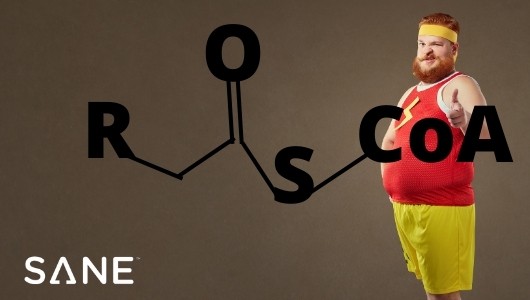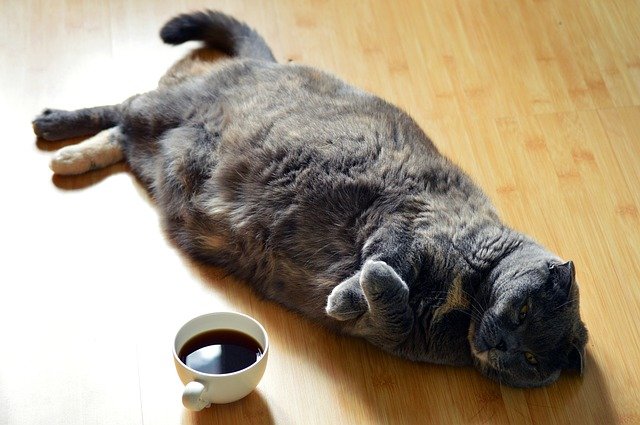Lipogenesis: triglyceride for storage in fat
Table of Contents
The process of creating new body fat is called lipogenesis (lipo = fat and genesis = creation). And with genesis in mind, in the beginning there was food, and food was classified by its dominant macronutrient. Vegetables, fruit, most dairy, beans, and everything else is a carbohydrate. They are not proteins or fats, so what else could they be?
How triglycerides work in lipogenesis
Specifically, body fat gets stored through a metabolic process where acetyl-CoA is converted to triglyceride. Then, it’s converted to storage in fat. The triglycerides in fat are packaged within cytoplasmic lipid droplets.
Here is the chemical structure of Acetyl-CoA involved in lipogenesis:
As soon as our body gets its hands on protein, fat, or carbohydrate, it turns them into amino acids, fatty acids, or glucose, respectively.
Once fat is converted to fatty acids, if there are more fatty acids around than we currently need, all of them are sent off to be stored as body fat. The glucose we get from carbohydrates does not work that way.
Postbiotics supplements are the perfect solution for that body fat and Viscera-3 by SANESolution is what you’re looking for.
Glucose cannot be stored as body fat without the hormone insulin. And then there are amino acids from protein. Amino acids must first be converted into glucose. Once they become glucose, they need insulin or they cannot be stored as body fat.
Now let’s assume the hormone insulin is making its rounds and we have glucose on its way to fat cells. At that point all remaining glucose is converted into fatty acids and we are one step away from new body fat.
During the last step in the process all those fatty acids combine with a glycerol molecule to form triglyceride—aka body fat. This is called esterification and it is not possible without a substance called glycerol-3-phosphate.

How Fat is Created: From Food to Body Fat
How fat is made in the body, why and how it is formed, and how is it produced is important to understand. This will make losing unwanted fat less of a ‘black box’ and you may even prevent its formation.
How is this body fat storage scientific knowledge useful? Three ways:
- A calorie is not a calorie, considering that protein is five calorie-burning steps away from body fat—convert into amino acids, convert to glucose, meet up with insulin, transform to fatty acids, and hookup with glycerol-3-phosphate—while fat is only two calorie-burning steps away—convert into fatty acids and hook up with glycerol-3-phosphate.
- It is impossible to store glucose as body fat without enough insulin. The more Aggressive a calorie is, the more insulin it triggers. That is one of the reasons we do not like Aggressive calories.
- No body fat gets stored without glycerol-3-phosphate. Guess where we get the most glycerol-3-phosphate? InSANE starches and sweets. Carbohydrates are not bad. Non-starchy vegetables are carbohydrates and they are the most SANE foods around. It is just that inSANE carbohydrate from starches and sweets fuel body fat formation.
Put this all together and it gets clearer why eating more—smarter—works while eating less does not. When people eat less, they are still overeating since their metabolism slows down. Additionally, they have plenty of insulin and glycerol-3-phosphate thanks to the inSANE low-quality starches and sweets they continue eating. Overeating plus insulin and glycerol-3-phosphate means new body fat.
On the other hand, when we eat more—smarter:
- We avoid overeating thanks to high-Satiety.
- We get calories into our bloodstream slowly and they trigger little insulin thanks to low-Aggression.
- We maximize the number of nutrients we get from those calories thanks to high-Nutrition.
- We burn a lot of calories during digestion thanks to low-Efficiency.
Eating all this SANE food makes us too full for inSANE starches and sweets. By avoiding starches and sweets, we do not have enough insulin or glycerol-3-phosphate to fuel body fat formation. Free from excess insulin and glycerol-3-phosphate, we eat more food and store less body fat.
- Advanced Nutrition and Human Metabolism, James L. Groff, and Sareen S. Gropper
- Elliott SS, Keim NL, Stern JS, Teff K, Havel PJ. Fructose, weight gain, and the insulin resistance syndrome. Am J Clin Nutr. 2002 Nov;76(5):911-22. Review. PubMed PMID: 12399260.
- Havel PJ. Dietary fructose: implications for dysregulation of energy homeostasis and lipid/carbohydrate metabolism. Nutr Rev. 2005 May;63(5):133-57.Review. PubMed PMID: 15971409.
- Whitehead, Saffron A.; Nussey, Stephen (2001). Endocrinology: an integrated approach. Oxford: BIOS. pp. 122. ISBN 1-85996-252-1.









